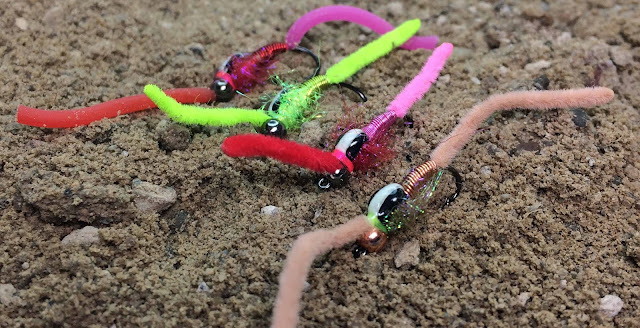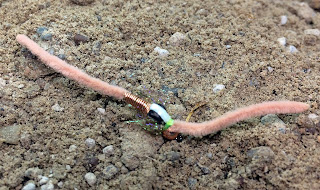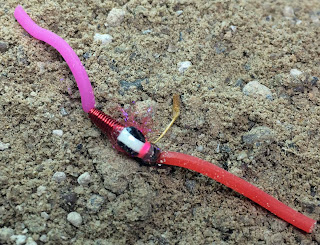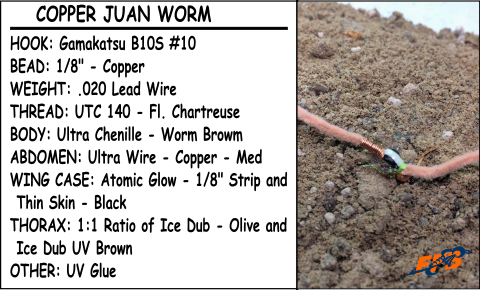~By: Lance Dean | May 21, 2017
Worms provide a great source of calories for trout and because trout are opportunistic they will eat a juicy worm when they see one. While in my early to mid-twenties my Dad and I hit a small stream here in Nevada. The snow put a freezing chill to the water as it quickly melted. As he rigged up his fly rod, my dad pulled out two containers of night crawlers. I thought to myself why the worms if we have fly rods. He proceeded to rig his fly rod, but rather than tie a fly to his leader, he tied on a snelled hook and attached a worm to it. And because my Dad was what I considered a master fisherman, I followed suit. I watched my Dad at the first hole. He tossed his worm upstream and then watched his fly line as the worm sank and was forced downstream. When the tip of his fly line suddenly stopped, he set the hook. He had one, first cast – first fish. What came out of the water was about what I expected for a stream as small as the one we were fishing that day. Not very big, it might have been 8-10 inches.
After dad took care of his fish, it was my turn. Now, this particular hole sat along a six foot stone wall that created a shadow over the deep, dark pool of water. How deep I couldn’t tell you. How dark, dark enough. My Dad suggested that I toss , cause we weren’t fly casting and tossing about sums up what we were doing, the worm upstream as close to the wall as I could get it. The worm landed right where I commanded it to. It only took a few seconds for the worm to get down to where the trout sat waiting for poor, unsuspecting, calorie packed morsels to float by.
I watched the end of my floating line for any pause. When that pause came, I raised my rod high and felt the tugging of a bent rod that said “FISH ON!!!” I could tell something was different about the tugs I was feeling with this fish compared to the tugs I watched my Dad take on. It took a bit of solid fighting to get the fish to come up from the depths enough to see it. It was a nice fish. Lots bigger than the one my Dad caught. The fighting fish kept me on my toes and when he’d come up high enough for us to see him, that trout made another run towards the bottom of the pool. Dad’s hooting and hollering about the trout’s size only increased the excitement that built within me.
Our excitement boiled over just before a sense of relief calmed us when we landed that Brown Trout. The Brown was 22 inches long and had to be a monster for that little stream. As the day went on, Dad and I caught lots of fish and I even managed to pull another 21 inch Rainbow out of the stream later that day.
It was an epic day and I owed it to my Dad for deciding to hit that stream with different tactic than what I was accustomed to. The power of the worm on the fly rod, who would of thunk it!
I used this technique at a couple different streams and rivers throughout the years with much of the same success. Catching sizable fish in areas where fisherman suggest no size existed.
After one of these trips, while visiting a fishing store, I found some realistic plastic worms and wanted to see if I could get similar results as with a real worm. So I bought a couple packs of these rubber worms to test. They failed miserably; they did not perform as I had hoped. I eventually, put on a real worm and suddenly I was catching fish again. So what was wrong with the rubber worms that the fish didn’t like? As I stewed over this for a couple weeks I told myself that I bet that the fish didn’t take the rubber worms because the fish didn’t see them. There was and is a distinct weight difference between the rubber worms that I was testing versus real worms. Real worms were much heavier than the rubber ones I was using.
There are many worm patterns out there. There’s the San Juan Worm, Vladi’s Worm, Pigsticker, UV Worm, Squirmy Wormy, and many, many more. They all have their time and place to be effective. The most important feature for a worm pattern to have in my opinion is weight. They need to be heavy. They need to penetrate the water column and get down to where the fish are especially during high water time. That is why I came up with the Copper Juan Worm. Yes I am aware I didn’t actually come up with it but I designed it before I found it on the web. So, in my book, its mine. The Copper Juan Worm is obviously what it sounds like – a cross between a Copper John and the San Juan Worm. The Copper John is my favorite fly pattern and it is heavy, so I figured why not make the Copper John into a worm.
The Copper Juan Worm is a great fly for penetrating deep water. It is especially effective during run-off while the water flow runs fast and is rising. Use fluorescent colors when the water is muddy which is typical during a run-off period. Use natural browns, olives and blacks if the water is clear. My favorite colors are worm brown, dark brown, red/pink, and chartreuse.
The Copper Juan Worm ties basically like a Copper John but instead of a biots for a tail, use ultra or micro chenille or your favorite squirmy material. Be sure to tie in the front of the worm after you start the thread. No need for legs or a peacock herl thorax, instead use some sort of ice dub as a thorax and pick it out to create legs. A typical Copper John utilizes tinsel for a bit of flash over the wingcase, which works, but I have found that I like using Atomic Glow instead. Not that Atomic Glow fishes better than tinsel, Atomic Glow is just a different material that is pretty new to me and I like the bit of extra “POP” it gives the Copper Juan Worm. Oh and one more thing, if you tie the squirmy version tie the front of the worm so that you slide the bead over the squirmy material. If you’re tying the chenille version tie in the chenille behind the bead. If you are confused, just check out the videos below.
I like both versions, chenille and the squirmy, of the Copper Juan Worm, but I do believe that the chenille version is more durable than the squirmy version. Squirmy material doesn’t seem to hold up as well as chenille. The chenille version may beat the squirmy version in the durability department, but the squirmy version offers a bit more wiggle than the chenille version. Decide what is more important for the conditions you are fishing either durability or action – your call. Either way, tie up and keep a few of both of these pattern variations in your fly box for those times the fish will only move for a large, calorie packed morsel of goodness.
Please enjoy this demonstration of me tying these to versions of the Copper Juan Worm. And as usual please follow fishbaitsflybox.com by clicking HERE. “Like” Fishbait’s Fly Box on Facebook by clicking HERE and subscribe to Fishbait’s Fly Box on YouTube by clicking HERE and then click subscribe.
VIDEO:
VIDEO:
 |
| Copper Juan Worms |
After dad took care of his fish, it was my turn. Now, this particular hole sat along a six foot stone wall that created a shadow over the deep, dark pool of water. How deep I couldn’t tell you. How dark, dark enough. My Dad suggested that I toss , cause we weren’t fly casting and tossing about sums up what we were doing, the worm upstream as close to the wall as I could get it. The worm landed right where I commanded it to. It only took a few seconds for the worm to get down to where the trout sat waiting for poor, unsuspecting, calorie packed morsels to float by.
 |
| The Copper Juan Worm can be tied in many colors. |
Our excitement boiled over just before a sense of relief calmed us when we landed that Brown Trout. The Brown was 22 inches long and had to be a monster for that little stream. As the day went on, Dad and I caught lots of fish and I even managed to pull another 21 inch Rainbow out of the stream later that day.
It was an epic day and I owed it to my Dad for deciding to hit that stream with different tactic than what I was accustomed to. The power of the worm on the fly rod, who would of thunk it!
I used this technique at a couple different streams and rivers throughout the years with much of the same success. Catching sizable fish in areas where fisherman suggest no size existed.
After one of these trips, while visiting a fishing store, I found some realistic plastic worms and wanted to see if I could get similar results as with a real worm. So I bought a couple packs of these rubber worms to test. They failed miserably; they did not perform as I had hoped. I eventually, put on a real worm and suddenly I was catching fish again. So what was wrong with the rubber worms that the fish didn’t like? As I stewed over this for a couple weeks I told myself that I bet that the fish didn’t take the rubber worms because the fish didn’t see them. There was and is a distinct weight difference between the rubber worms that I was testing versus real worms. Real worms were much heavier than the rubber ones I was using.
There are many worm patterns out there. There’s the San Juan Worm, Vladi’s Worm, Pigsticker, UV Worm, Squirmy Wormy, and many, many more. They all have their time and place to be effective. The most important feature for a worm pattern to have in my opinion is weight. They need to be heavy. They need to penetrate the water column and get down to where the fish are especially during high water time. That is why I came up with the Copper Juan Worm. Yes I am aware I didn’t actually come up with it but I designed it before I found it on the web. So, in my book, its mine. The Copper Juan Worm is obviously what it sounds like – a cross between a Copper John and the San Juan Worm. The Copper John is my favorite fly pattern and it is heavy, so I figured why not make the Copper John into a worm.
 |
| The Squirmy Copper Juan Worm has some great action. |
The Copper Juan Worm ties basically like a Copper John but instead of a biots for a tail, use ultra or micro chenille or your favorite squirmy material. Be sure to tie in the front of the worm after you start the thread. No need for legs or a peacock herl thorax, instead use some sort of ice dub as a thorax and pick it out to create legs. A typical Copper John utilizes tinsel for a bit of flash over the wingcase, which works, but I have found that I like using Atomic Glow instead. Not that Atomic Glow fishes better than tinsel, Atomic Glow is just a different material that is pretty new to me and I like the bit of extra “POP” it gives the Copper Juan Worm. Oh and one more thing, if you tie the squirmy version tie the front of the worm so that you slide the bead over the squirmy material. If you’re tying the chenille version tie in the chenille behind the bead. If you are confused, just check out the videos below.
I like both versions, chenille and the squirmy, of the Copper Juan Worm, but I do believe that the chenille version is more durable than the squirmy version. Squirmy material doesn’t seem to hold up as well as chenille. The chenille version may beat the squirmy version in the durability department, but the squirmy version offers a bit more wiggle than the chenille version. Decide what is more important for the conditions you are fishing either durability or action – your call. Either way, tie up and keep a few of both of these pattern variations in your fly box for those times the fish will only move for a large, calorie packed morsel of goodness.
Please enjoy this demonstration of me tying these to versions of the Copper Juan Worm. And as usual please follow fishbaitsflybox.com by clicking HERE. “Like” Fishbait’s Fly Box on Facebook by clicking HERE and subscribe to Fishbait’s Fly Box on YouTube by clicking HERE and then click subscribe.
VIDEO:


